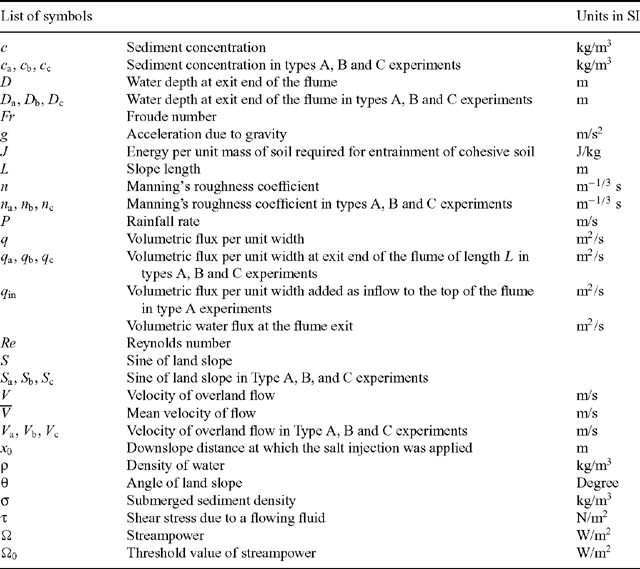Investigation of the interaction between flow-driven and rainfall-driven erosion processes
H. Rouhipour A , H. Ghadiri B C and C. W. Rose BA Research Institute of Forests and Rangelands, PO Box 13185-116, Tehran, Iran.
B Centre for Riverine Landscapes, Faculty of Environmental Sciences, Griffith University, Nathan, Qld 4111, Australia.
C Corresponding author. Email: H.Ghadiri@griffith.edu.au
Australian Journal of Soil Research 44(5) 503-514 https://doi.org/10.1071/SR05006
Submitted: 13 January 2005 Accepted: 27 March 2006 Published: 4 August 2006
Abstract
The effect of interaction between erosion processes has received only limited direct attention by researchers in the field of soil erosion by water. In modelling the processes involved in erosion it is uncertain whether it is justifiable to simply add the contribution of each of the separate erosion processes to give the total sediment concentration, or whether there may be some positive or negative interaction between flow-driven and rainfall-driven processes. Most laboratory experiments have shown that generally the rate of erosion in a rain-impacted flow is greater than for un-impacted flows of similar depth and velocity, indicating positive interaction. The experiments reported in this paper were carried out in the Griffith University Tilting Flume Simulated Rainfall (GUTSR) facility (5.8 by 1.0 m), using 2 different soil materials. Sediment concentration due to flow-driven and rainfall-driven erosion processes, or combination of both processes, depended on factors such as soil characteristics and streampower of the flow, and varied with time, tending to steady-state values. Interaction was defined as positive if the sediment concentration produced by both rainfall and overland flow acting together exceeded the sum of their individual concentrations. Such interaction was positive for a silty loam soil, but negative for a loamy sand. Reasons for the unexpected negative interaction are uncertain, but may be due to the suppression by rainfall of micro-rills or proto-rills, which tended to form preferentially on the loamy sand under flow alone.
Additional keywords: processes-based models, flow-driven, rainfall-driven, interaction, silty soil, loamy sand.
Cruse RM, Larson WE
(1977) Effect of soil shear strength on soil detachment due to raindrop impact. Soil Science Society of America Proceedings 41, 777–781.

Dillaha TA, Beasley DB
(1983) Distributed parameter modelling of sediment movement and particles size distribution. Transactions of the American Society of Agricultural Engineers 26, 1766–1772, 1777.

Ghadiri H, Payne D
(1977) Raindrop impact stress and breakdown of soil crumbs. Journal of Soil Science 28, 247–258.
| Crossref |

Gilley JE, Finkner SC
(1985) Estimating soil detachment caused by raindrop impact. Transactions of the American Society of Agricultural Engineers 28, 140–146.

Guy BT,
Dickinson WT, Rudra RP
(1987) The roles of rainfall and runoff in the sediment transport capacity of interrill flow. Transactions of the American Society of Agricultural Engineers 30, 1378–1386.

Hairsine PB, Rose CW
(1991) Rainfall detachment and deposition: Sediment transport in the absence of flow driven processes. Soil Science Society of America Journal 55, 1176–1183.

Hairsine PB, Rose CW
(1992a) Modelling water erosion due to overland flow using physical principles. 1. Sheet flow. Water Resources Research 28, 237–243.
| Crossref | GoogleScholarGoogle Scholar |

Hairsine PB, Rose CW
(1992b) Modelling water erosion due to overland flow using physical principles. 2. Rill flow. Water Resources Research 28, 245–250.
| Crossref | GoogleScholarGoogle Scholar |

Hogarth WL,
Rose CW,
Parlange JY,
Sander GC, Carey C
(2004) Soil erosion due to rainfall impact with no inflow: a numerical solution with spatial and temporal effects of sediment settling velocity characteristics. Journal of Hydrology 294, 229–240.
| Crossref | GoogleScholarGoogle Scholar |

Kinnell PIA
(2001) Comments on ‘Vertical Hydraulic Gradient and Run-on Water and Sediment Effects on Erosion Processes and Sediment Regimes’. Soil Science Society of America Journal 65, 953–954.

Li G,
Abrahams AD, Atkinson JF
(1996) Correction factor in the determination of mean velocity of overland flow. Earth Surface Processes and Landforms 21, 509–515.
| Crossref | GoogleScholarGoogle Scholar |

Luk SH, Merz W
(1992) Use of the salt tracing technique to determine the velocity of overland flow. Soil Technology 5, 289–301.

Meyer LD, Monke EJ
(1965) Mechanic of soil erosion by rainfall and overland flow. Transactions of the American Society of Agricultural Engineers 8, 572–580.

Misra RK, Rose CW
(1995) An examination of the relationship between erodibility parameters and soil strength. Australian Journal of Soil Research 33, 715–732.
| Crossref | GoogleScholarGoogle Scholar |

Moss AJ,
Walker PH, Hutka J
(1979) Raindrop-simulated transportation in shallow water flow: An experimental study. Sedimentary Geology 22, 165–184.
| Crossref | GoogleScholarGoogle Scholar |

Nearing MA,
Foster GR,
Lane LJ, Finker SC
(1989) A process-based soil erosion model for USDA-Water Erosion Prediction Project technology. Transactions of the American Society of Agricultural Engineers 32, 1587–1593.

Palmer RS
(1965) Water impact forces. Transactions of the American Society of Agricultural Engineers 8, 69–72.

Proffitt APB, Rose CW
(1991) Soil erosion processes. I. The relative importance of rainfall detachment and runoff entrainment. Australian Journal of Soil Research 29, 671–683.
| Crossref | GoogleScholarGoogle Scholar |

Rouhipour H,
Rose CW,
Ghadiri H, Yu B
(1999.) Roughness coefficients and velocity estimation in well-inundated sheet and rilled overland flow without strongly eroding bed forms. Earth Surface Processes and Landforms 24, 233–245.
| Crossref | GoogleScholarGoogle Scholar |

Sander GC,
Hairsine PB,
Rose CW,
Cassidy D,
Parlange JY,
Hogarth WL, Lisle I
(1996) Unsteady soil erosion model, analytical solutions and comparison with experimental results. Journal of Hydrology 178, 351–367.
| Crossref | GoogleScholarGoogle Scholar |

Savat J
(1977) The hydraulic of sheet flow on a smooth surface and the effect of simulated rainfall. Earth Surface Processes 2, 125–140.

Savat J
(1980) Resistance to flow in rough supercritical sheet flow. Earth Surface Processes 5, 103–122.

Shen HW, Li RM
(1973) Rainfall effect on sheet flow over smooth surface. Journal of the Hydrological Division ASCE 99, 771–792.

Singer MJ, Walker PH
(1983) Rainfall runoff in soil erosion with simulated rainfall, overland flow and cover. Australian Journal of Soil Research 21, 109–122.
| Crossref | GoogleScholarGoogle Scholar |

Yoon YN, Wenzel HG
(1971) Mechanics of sheet flow under simulated rainfall. Journal of the Hydrological Division ASCE 97, 1367–1386.


|


